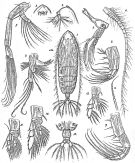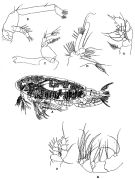|
|
 |
Fiche d'espèce de Copépode |
|
|
Calanoida ( Ordre ) |
|
|
|
Arietelloidea ( Superfamille ) |
|
|
|
Augaptilidae ( Famille ) |
|
|
|
Haloptilus ( Genre ) |
|
|
| |
Haloptilus validus Sars, 1920 (F) | |
| | | | | | | Ref.: | | | Sars, 1920 c (p.11, Rem.F); 1925 (p.241, figs.F); Rose, 1933 a (p.211, figs.F); Sewell, 1947 (p.194, figs.F); Tanaka & Omori, 1971 (p.255, figs.F); Matthews, 1972 (p.55); Park, 1988 (p.3); Boxshall & Halsey, 2004 (p.67: figs.F); Vives & Shmeleva, 2007 (p.251, figs.F, Rem.) |  Issued from : G.O. Sars in Résult. Camp. Scient. Prince Albert I, 69, pls.1-127 (1924). [Pl.LXVIII, figs.1-14]. Female: 1, habitus (dorsal); 2, forehead (lateral); 3, idem (ventral view); 4, A1; 5, A2; 6, Md; 7, Mx1; 8, Mx2; 9, Mxp; 10, terminal portion of distal spines of Mxp (enlarged); 11, P1; 12, P3; 13, P5; 14, urosome (dorsal).
|
 issued from : R.B.S. Sewell in The John Murray Expedition, 1933-34, Scientific Reports, VIII (1), 1947. [p.195, Fig.50, A-G]. Female (from Central part of Arabian Sea): A, habitus (left dorso-lateral); B, A2; C, Md; D, Mx1; E, Mx2; F, P1; G, P5. Nota: The proportional lengths of the cephalothorax and abdomen as 85.5 to 14.5. The proportional lengths of the various segments of the body (cephalon to caudal rami) as 501:131:75:67:83:56:16:8:21:42 = 1000. The forehead is produced in a small spinous projection. A1 25-segmented, overreaches the tip of the caudal rami by about the last two segments. In A2 the exopod is less than half the length of the endopod. In Mx1 the biting lobe tapers towards the distal end and bears 2 stout serrated teeth and 4 delicate setae, the 2nd inner lobe is small and rounded and bears 1 long seta, the 3rd inner lobe bears 3 setae; the 2nd basal segment bears 5 setae; endopod much reduced and forms a small rounded lobe bearing 2 setae; exopod long, slender and bears 10 setae, of which the proximal 6 are well developed and the distal 4 small and delicate; the outer lobe bears 3 (2 visible on the figure) very delicate proximal setae and 6 well-developed distal ones. In Mx2 the 1st lobe bears 3 setae and is produced in a small pointer process, lobes 2, 3 and 4 each bear 2 setae, the 5 th lobe bears 1 seta and 1 stout serrated spine.
|
 issued from : O. Tanaka & M. Omori in Publ. Seto Mar. Biol. Lab., 1971, XIX, 4. [p.256, Fig.3]. Female (from Izu Region):a, habitus (dorsal); b, forehead (lateral); c, last thoracic segment and urosome (left lateral); d, A2; e, Md; f, Mx1; g, Mx2; h, Mxp; i, P1; j, P2; k, P5. Nota: A1 25-segmented, exceeds the end of caudal rami by distal 5 segments.
| | | | | Ref. compl.: | | | Sewell, 1948 (p.330, 504, 509, 522, 528, 530, 539); C.B. Wilson, 1950 (p.237); De Decker & Mombeck, 1964 (p.12); Mazza, 1966 (p.72); Grice & Hulsemann, 1967 (p.19); Vaissière & Séguin, 1980 (p.23, tab.2); Kovalev & Shmeleva, 1982 (p.84); Galbraith, 2009 (pers. comm.); Mazzocchi & Di Capua, 2010 (p.424); Chaouadi & Hafferssas, 2018 (p.913, Table II: occurrence); Belmonte, 2018 (p.273, Table I: Italian zones) | | | | NZ: | 6 | | |
|
Carte de distribution de Haloptilus validus par zones géographiques
|
| | | | | | | | | | Loc: | | | South Afica (E), Canary Is., Medit. (Sidi Fredj, Ligurian Sea, Tyrrhenian Sea, Strait of Messina, S Adriatic Sea, Ionian Sea), Arabian Sea, Indian, Japan (Izu), Pacif. (off SW Galapagos), Vancouver Is. | | | | N: | 14 | | | | Lg.: | | | (1) F: 6,3; (11) F: 6; (90) F: 6,09; {F: 6,00-6,30} | | | | Rem.: | méso-bathypélagique
Voir aussi les remarques en anglais | | | Dernière mise à jour : 07/12/2020 | |
|
|
 Toute utilisation de ce site pour une publication sera mentionnée avec la référence suivante : Toute utilisation de ce site pour une publication sera mentionnée avec la référence suivante :
Razouls C., Desreumaux N., Kouwenberg J. et de Bovée F., 2005-2025. - Biodiversité des Copépodes planctoniques marins (morphologie, répartition géographique et données biologiques). Sorbonne Université, CNRS. Disponible sur http://copepodes.obs-banyuls.fr [Accédé le 03 juillet 2025] © copyright 2005-2025 Sorbonne Université, CNRS
|
|
 |
 |






